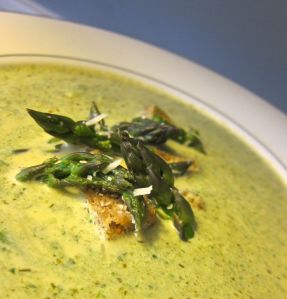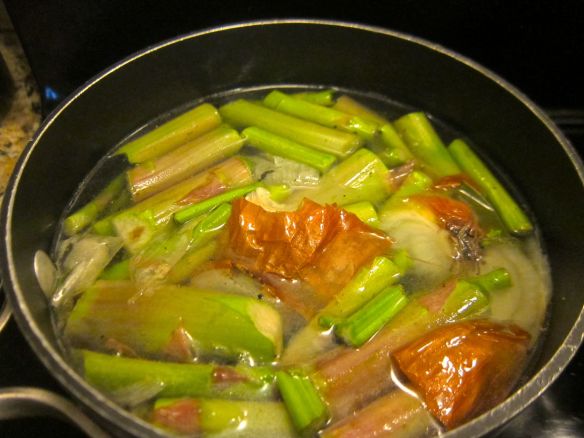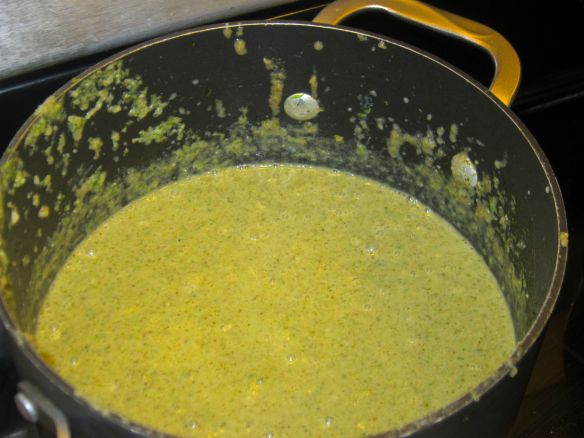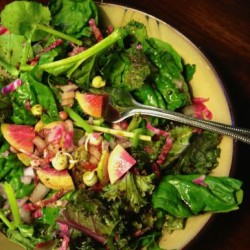Friday, May 31, 2013
 I’ve shown a lot of asparagus love in the past week featuring a series of posts dedicated to one of spring’s beloved vegetables: lemon-scented roasted asparagus, herb-roasted salmon with roasted asparagus and parsnip purée, a savory open-faced egg and asparagus sandwich, and the French favorite of two sunny-side up eggs atop parmesan-inflected roasted asparagus. Finishing off the set is today’s recipe for asparagus soup. Not too difficult to make at all, and you even get to employ the tough, woody ends in an asparagus stock to use all parts of the vegetable, which I love.
I’ve shown a lot of asparagus love in the past week featuring a series of posts dedicated to one of spring’s beloved vegetables: lemon-scented roasted asparagus, herb-roasted salmon with roasted asparagus and parsnip purée, a savory open-faced egg and asparagus sandwich, and the French favorite of two sunny-side up eggs atop parmesan-inflected roasted asparagus. Finishing off the set is today’s recipe for asparagus soup. Not too difficult to make at all, and you even get to employ the tough, woody ends in an asparagus stock to use all parts of the vegetable, which I love.
As it turns out, today’s ninety-plus degrees in New England will have no one at all making this soup tonight.
Nevertheless.
Asparagus Soup
Ingredients and Instructions
1. Make the stock by snapping the ends off the rinsed asparagus and add to a pot along with the peels from the onion and garlic (that you’ll be using in the soup) along with 6-8 cups of water. Feel free to add a few peppercorns, parsley sprigs, and whatnot while you’re add it. Read more details on making veggie stock are here; this is a simpler Asparagus officinalis version, which includes the tough asparagus ends and uses fewer other ingredients like veggie peels. (I later added parsley, which I found in the fridge, along with a few peppercorns and bay leaf.)

Forty minutes later the water has extracted the nutrients and flavor from the veggies to form a delightful asparagus-flavored stock.

2. Roast the asparagus as described here while the stock is simmering, (Omit the lemon zest for this recipe.) Add a few bulbs of whole garlic alongside the asparagus, too. Just a drizzle of olive oil and a bit of salt and pepper is all you need.

Roasting garlic really brings out the sweetness and flavor. Nice caramelization, right?

3. Sauté chopped onion in olive oil in a large soup pot until translucent, about 5-7 minutes over medium heat, and season with salt and pepper
4. Chop the asparagus, saving a few tops for garnish, and toss the rest into the soup pot along with the garlic and stock. Bring to a boil and simmer 10-15 minutes or so.
5. Blend to create a homogeneous texture. (Optional: save some chopped asparagus to include at the end if you prefer a chunky soup.) The soup is looking good, but we still need to add our spices and a few more ingredients.

6. Season with dry mustard (~1 tsp), white or black pepper, salt (as needed), and a few grates of nutmeg. Cream and freshly grated parmigiana reggiano add body, texture, and overall deliciousness; add a little at a time until the desired texture and taste is achieved.
7. Garnish with a few of the reserved asparagus tops, homemade whole grain croutons (I’ll provide a recipe one of these days), and a few grates of the cheese. Don’t forget a grind of fresh pepper, too!

Cooking options. I love using roasted vegetables in soups, which in my extensive soup-making experience creates a tastier result than either steaming or boiling. However, either of these methods can be employed if you like, and the soup will still be quite lovely. If you boiled the asparagus, you’d can including the cooking water in the soup, too. Steaming has the advantage of creating a lively green hue, which doesn’t quite happen to the same degree when roasting (i.e., the soup will generally be grayer). You’ll find this crazy, perhaps, but I sometimes use a combination of roasted and steamed to achieve the best of both flavor and color. I say all of this so you are aware of the various cooking options, which take different amounts of time; select the method that fits your schedule and tastes.
What else to say? Well, I guess I’ll just remind you that I generally focus on ingredients and technique, which is why there aren’t always specific quantities provided on my blog recipes, as in today’s soup. This is a great opportunity to practice your skill as a cook, tasting and seasoning as you go along to make the perfect soup for you and your family.
I hope you get a chance to make this fabulous soup while asparagus is still in season, however you do it.
And don’t forget to freeze some so you’ll have it on hand when you’re craving a delightful soup celebrating spring.
Say, when it’s not ninety degrees.





Is there a list of ingredients I’m missing?
They are embedded in the post. I’ve gotten better about writing out precise recipes (check out my philosophies on recipes here) but I haven’t always followed traditional cookbook format on all my posts, especially my earlier ones. I know it can be a bit frustrating, and that’s why (among other reasons) I’m currently writing a cookbook! 🙂 Thanks for the comment. I hope you do find the recipes here on my blog with more traditional formatting; there are on here. Cheers, PKN